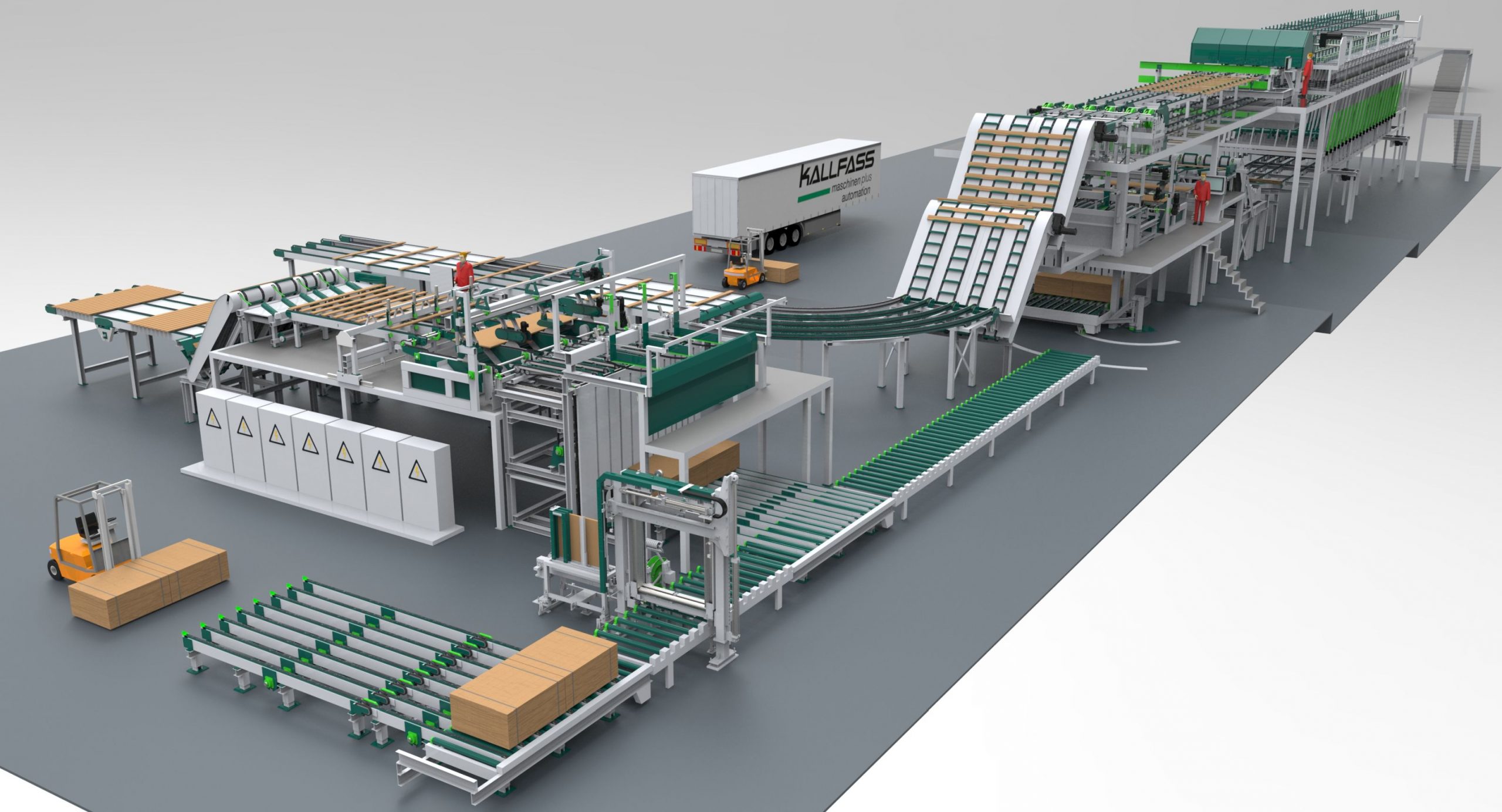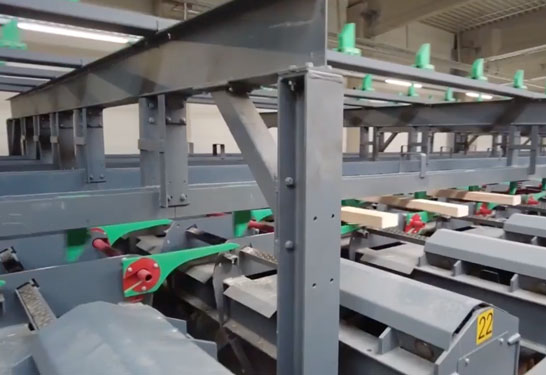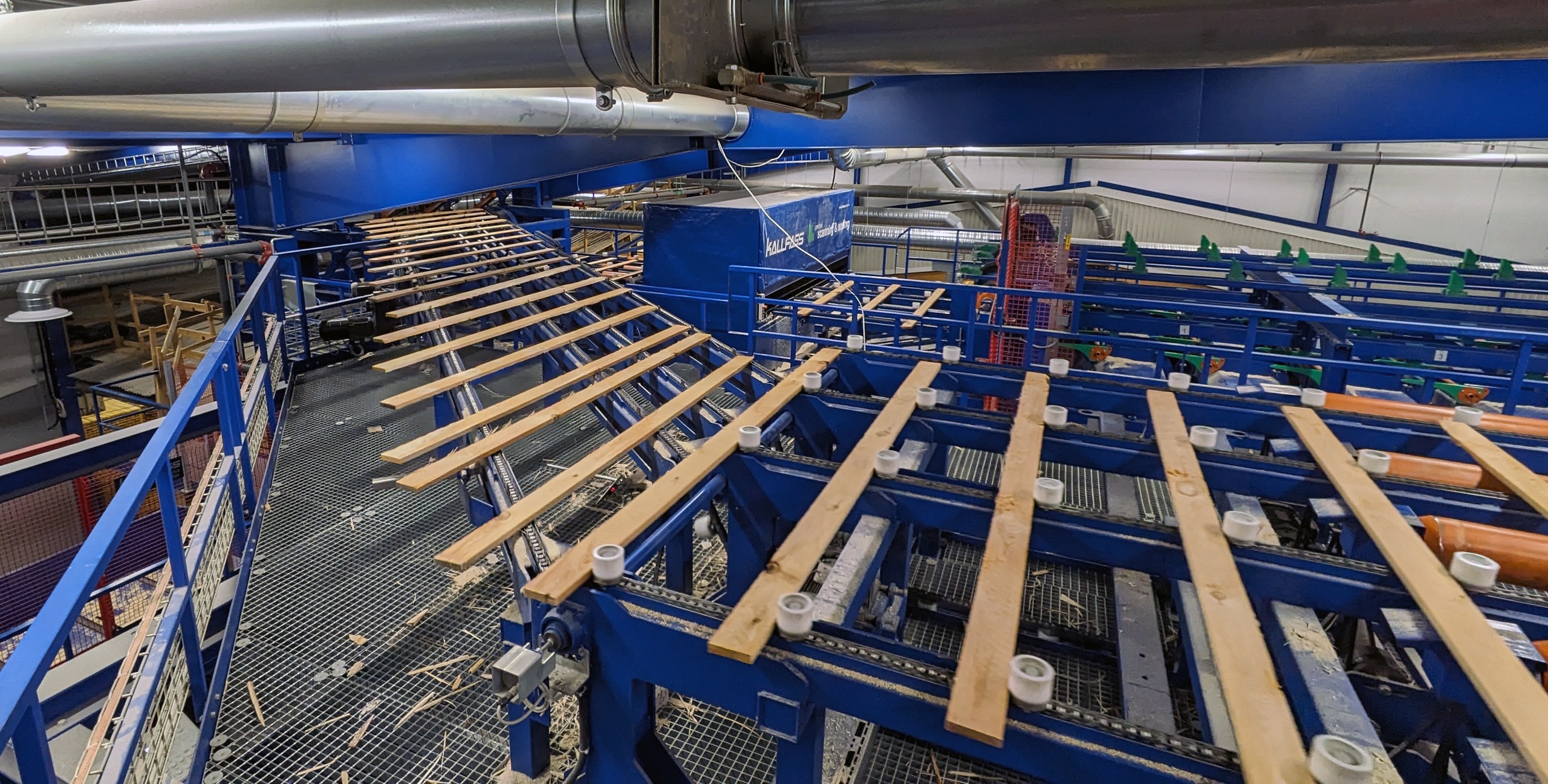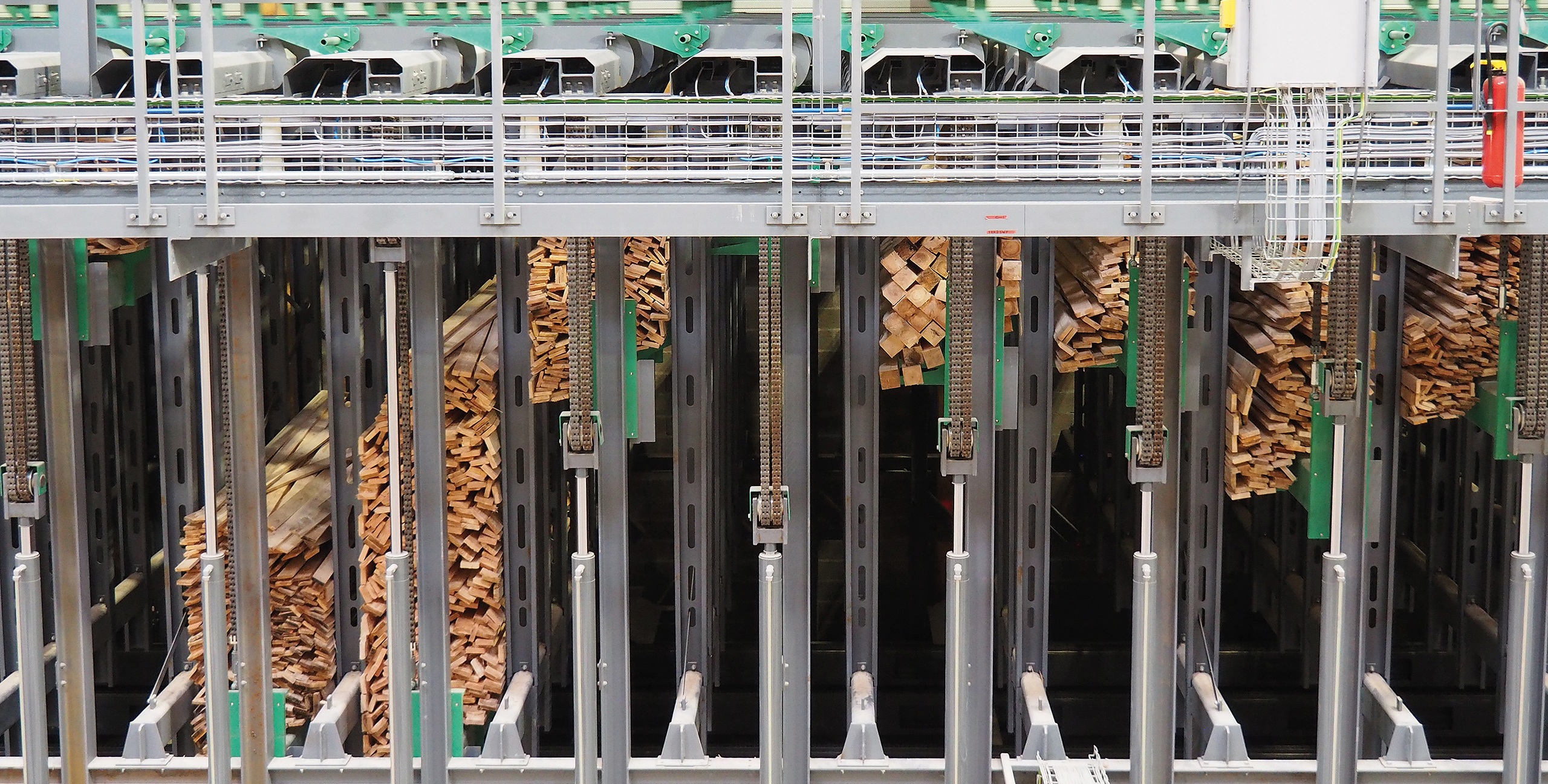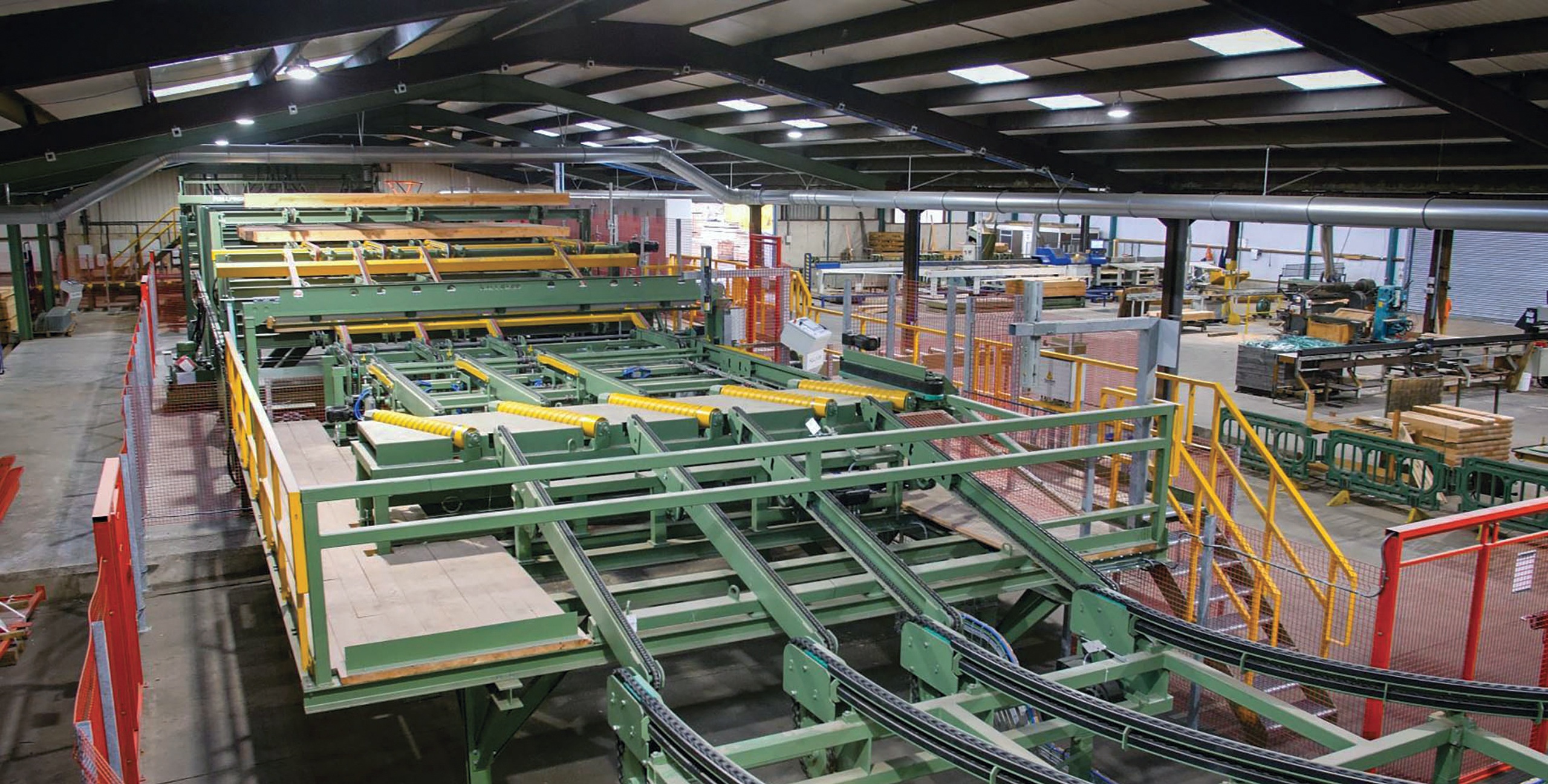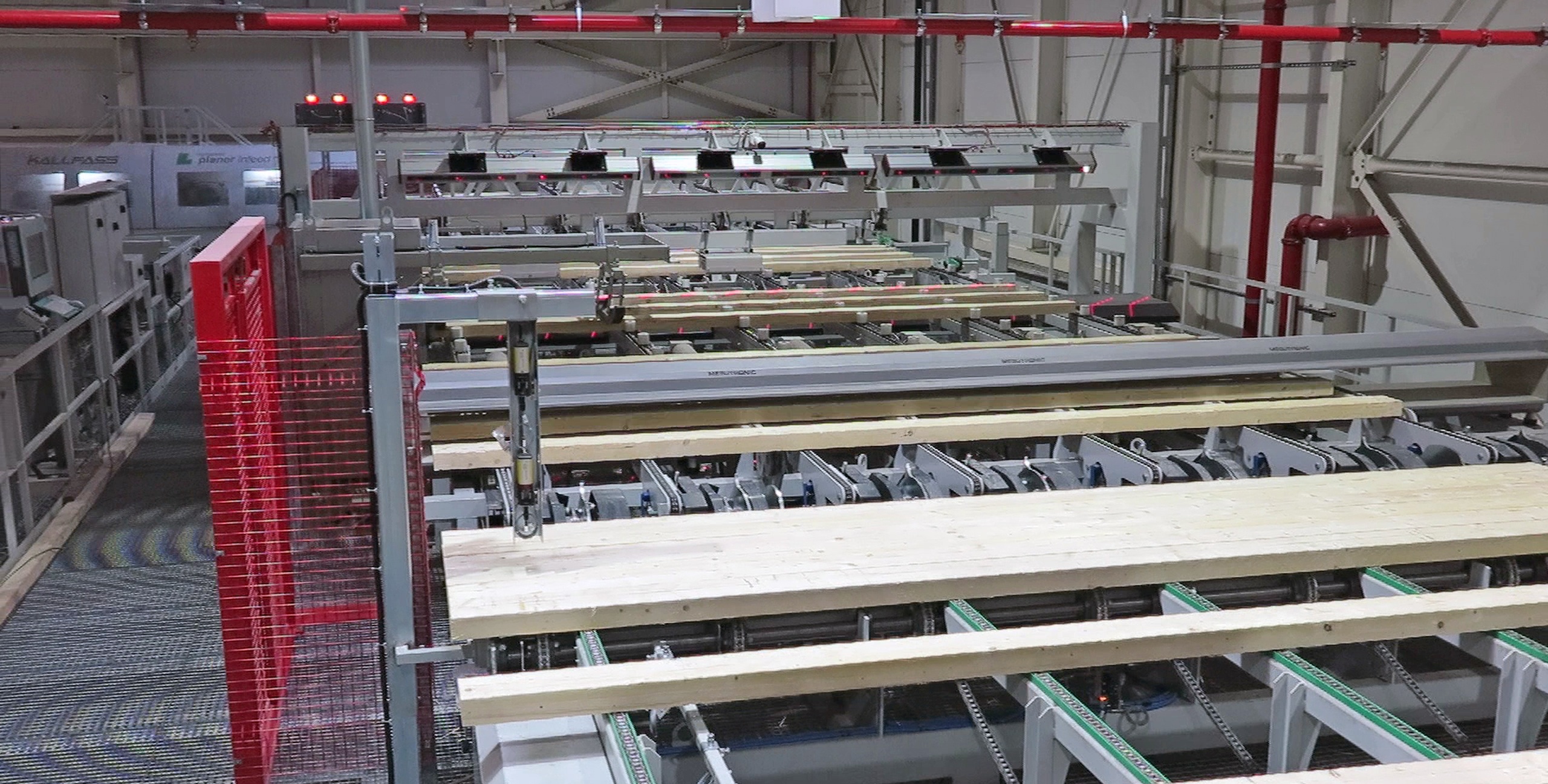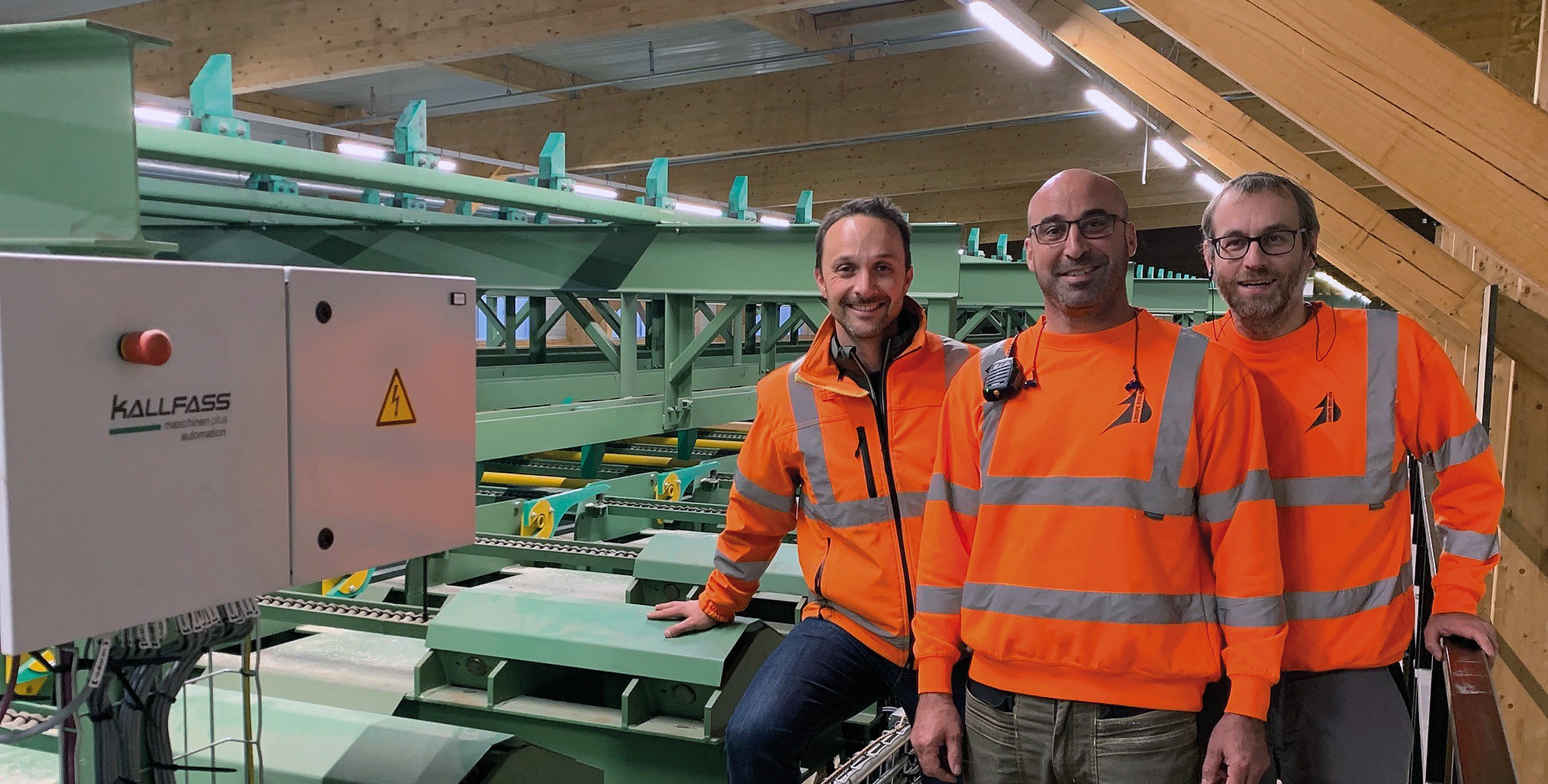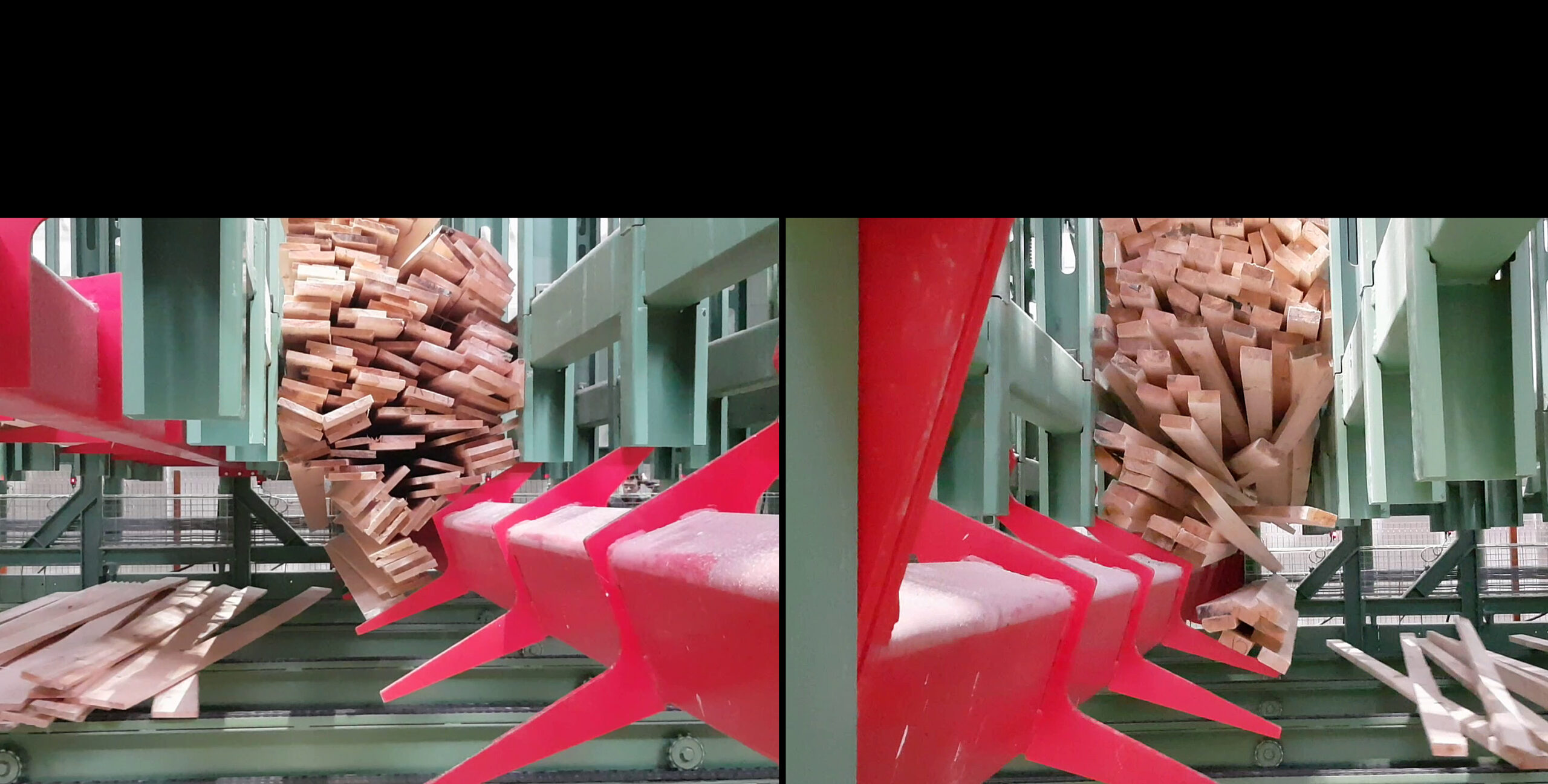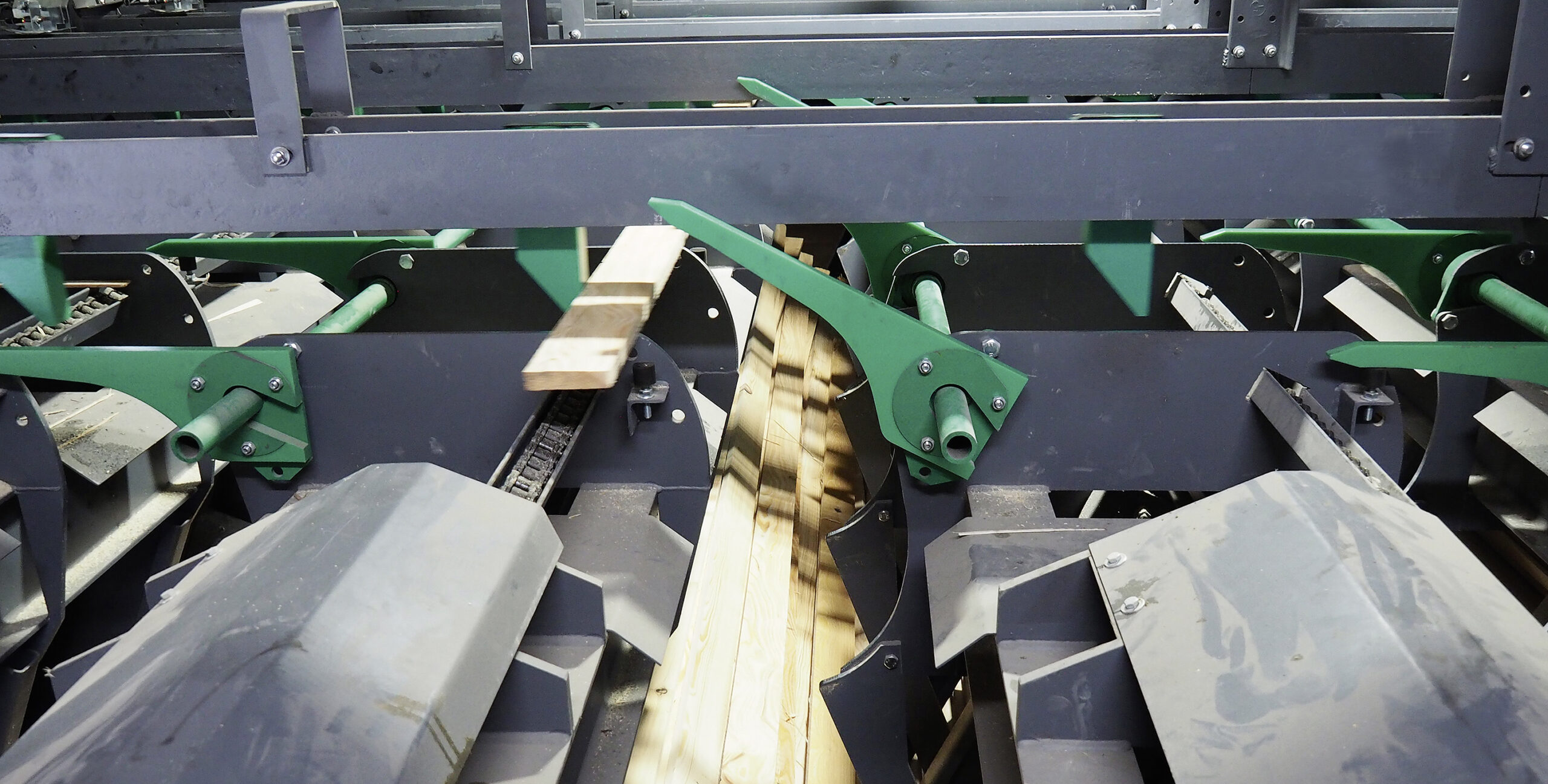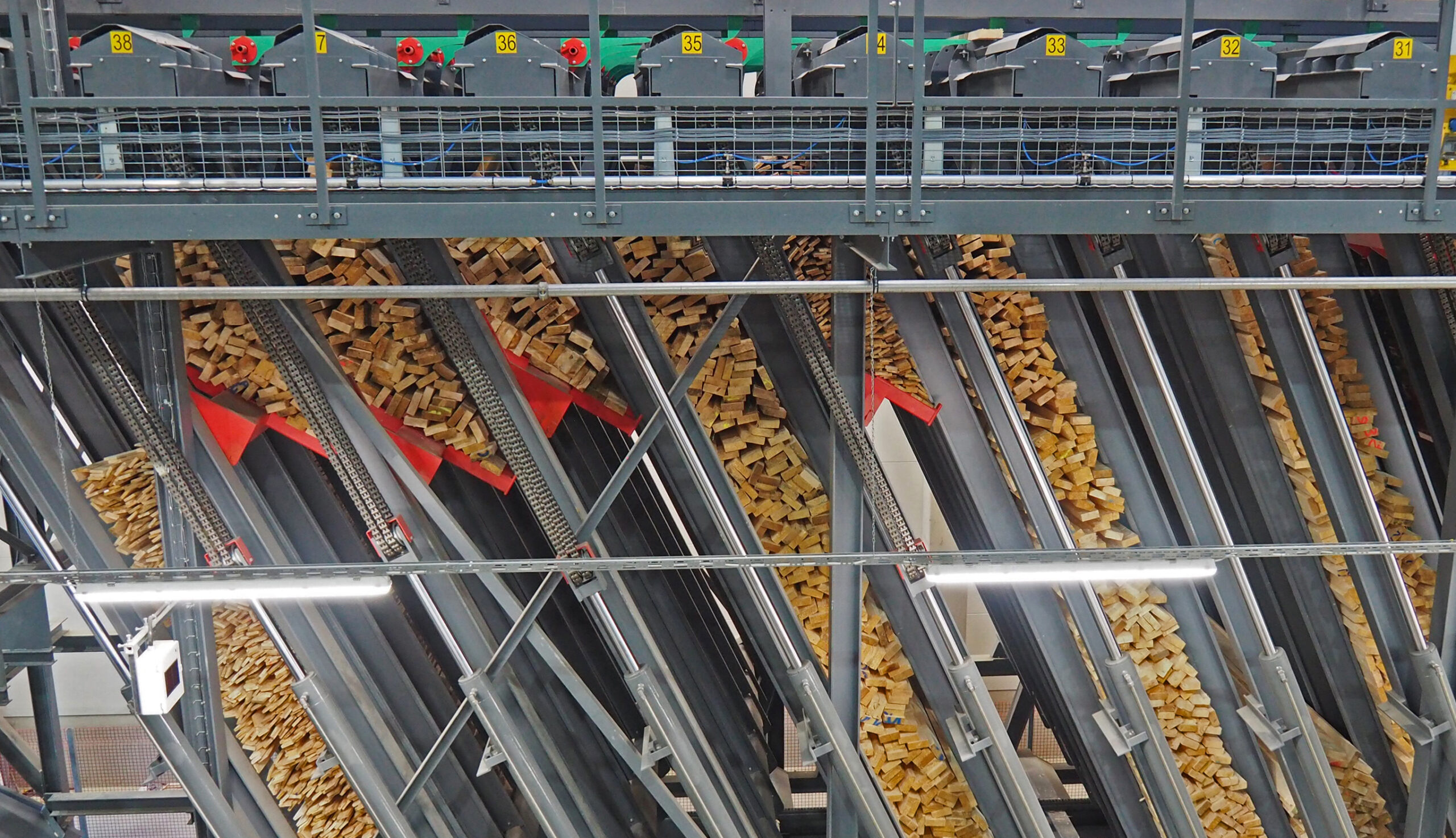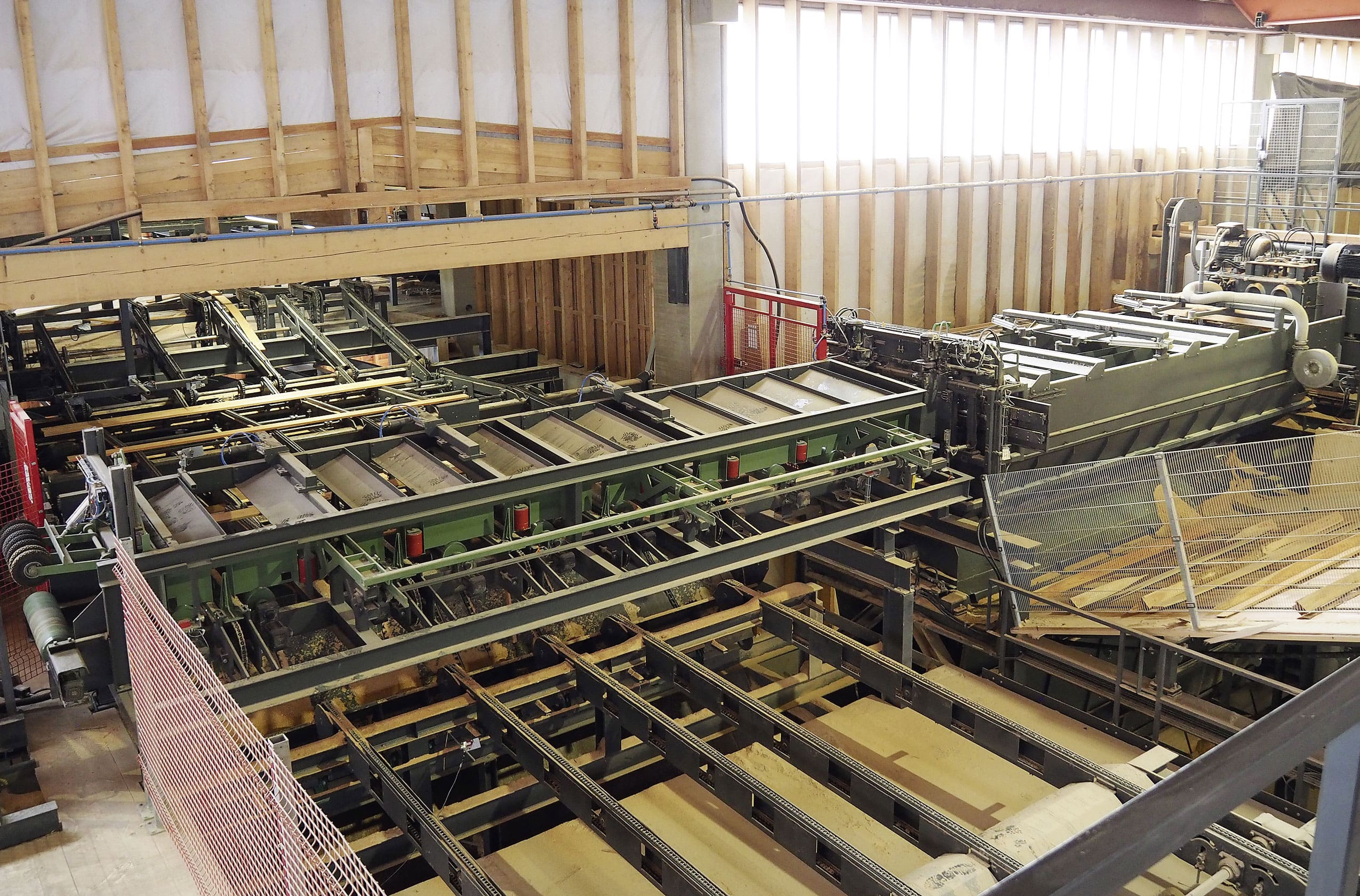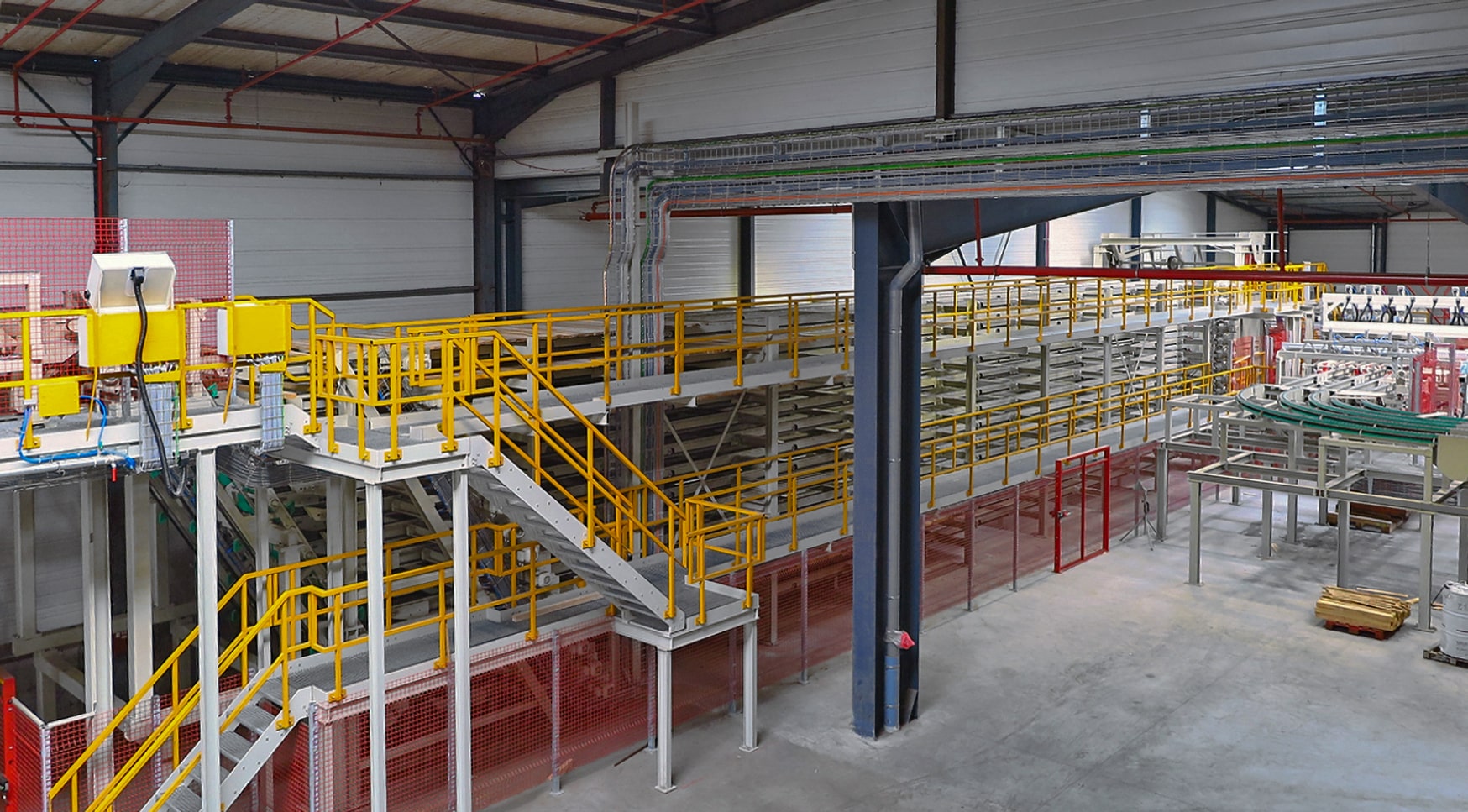Automation solution
Sorting
We develop efficient sorting solutions for classified timber suitable for every size of company. Integrated sorting control system provides information on filling levels, availability and dimensions at a single glance.
Installation example
Box sorter with inclined boxes
Controlled and gentle with material
Controlled timber sorting
UNSCRAMBLING WITH AND WITHOUT SINGLE FEED UNIT
Immediately after a sawing line or tilt destacking, it is often necessary, to separate the workpieces that arrive in a batch in order to form a material film/carpet from which they are then transferred individually or in layers to the next processing step. Depending on the required number of pieces and the material cross-sections, different technologies are used for separation or layer formation.
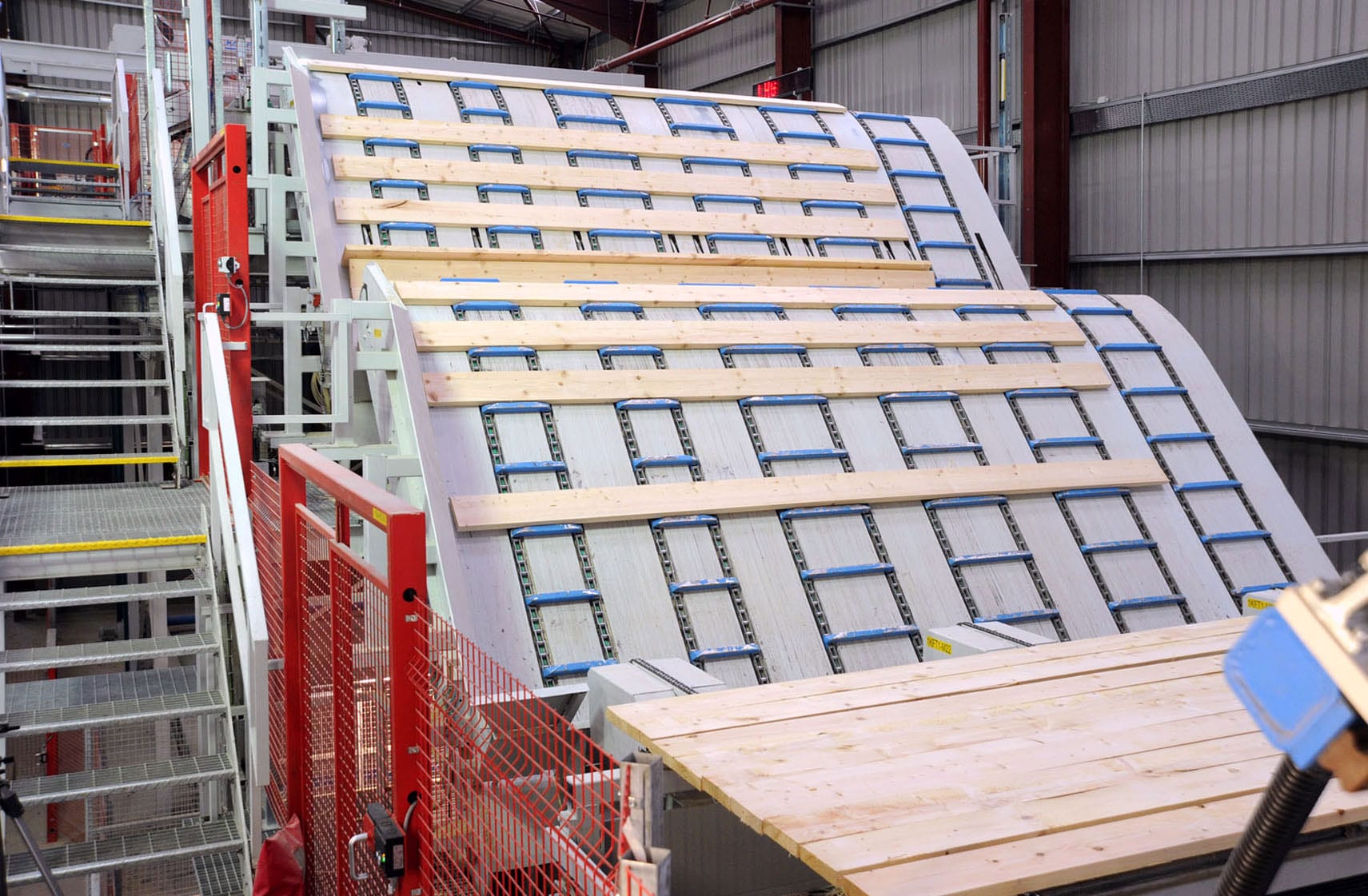
Continuity at high speed
Classified according to quality
FEEDING: Sorters
Before timber box or level sorters can be added, single item or mixed classification must first be realised according to dimensions and quality. This is aided by warping meters, moisture analysers and wane and quality scanners. Individually assessed sticks or boards are then conveyed on for sorting using a single feed unit or rejected.
Efficient and flexible
Filling at a high cycle rate
INCLINED BOX SORTER
Inclined box sorters are generally used in high-performance productions, as they can be filled at a high cycle rate of up to 160 pieces/min. They ensure reliable emptying of material and are therefore particularly recommended for sorting main boards with large material dimensions.
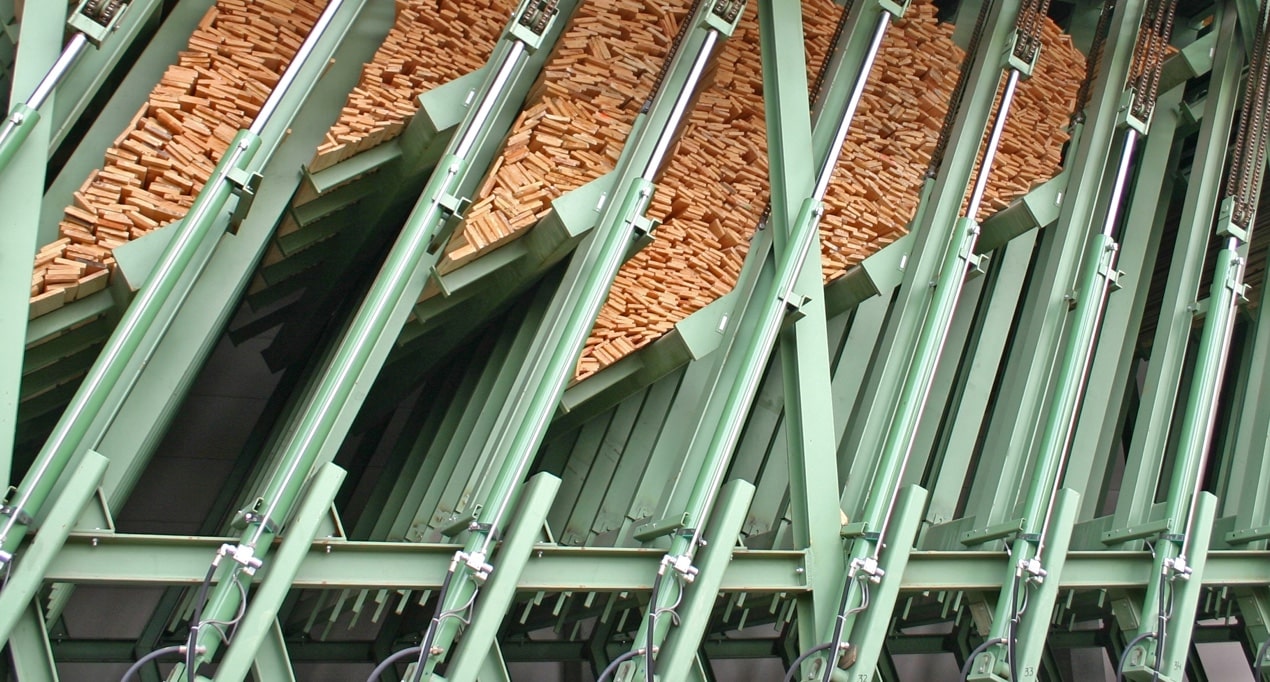
Sorting with a restricted space requirement
VERTICAL BOX SORTER
Use of a vertical box sorter can be sensible in confined space conditions, as vertical boxes need less space than inclined boxes and can accommodate more product boxes in the same area. Vertical boxes are mainly used for sorting side boards, as the box geometry makes emptying difficult and is not suitable for large material dimensions. The emptying direction can be suitably adapted to optimise the material flow. Vertical boxes are filled at a cycle rate of 120 pieces/min.
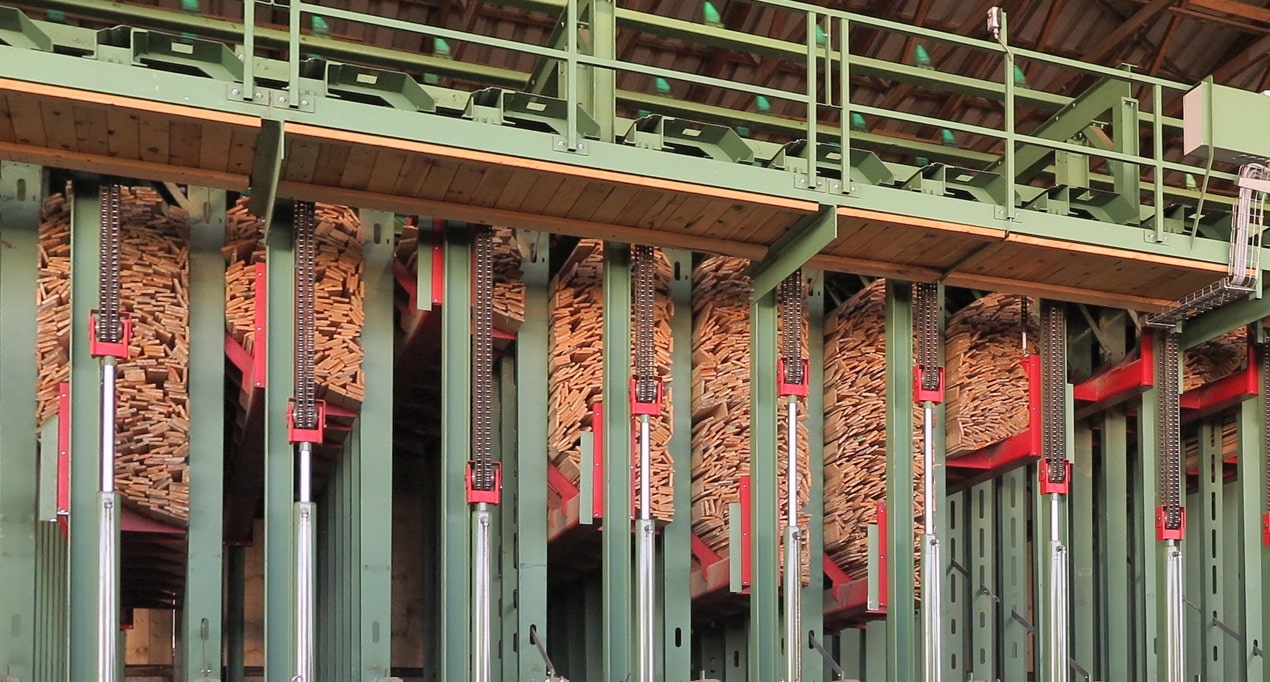
Timber product assortment
IDEAL VOLUME
The number of timber products determines the number of boxes. A box should ideally correspond to the volume of a stacked package, with the height of the boxes corresponding to the package cross section.
Time-saving process solutions
Fully automatic material flow
STACKING: Shipping packages
Stacking of timber (including in multiple lengths) can be realised with placement forks or vacuum lifters, with the timber being collected in layers and deposited layer by layer on the shipping package to be formed. Dispatch strips can be laid between several layers to stabilise the shipping package. Strip laying is automatic. Where necessary, the shipping package is stabilised additionally through final strapping. Squared timbers can be optionally included on the package underside, and the packages can be pressed hydraulically together if desired. Customers who do not wish to have stabilising strips (e.g. because the package only needs to be transported within the company) may avail of offset stacking.
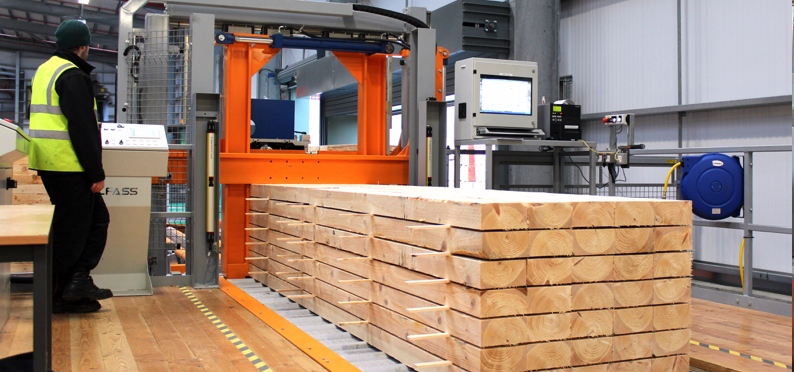
Effective air circulation, thanks to dry sticks
STACKING: Kiln packages
Wooden sticks are laid between each layer when stacking timber that is still damp in kiln packages. The intermediate sticks ensure adequate air circulation during drying and accelerate the drying process. The drying sticks are laid by stick magazines.
Option: Workpieces of different widths can also be stacked with spacing with the aid of a servo slide.
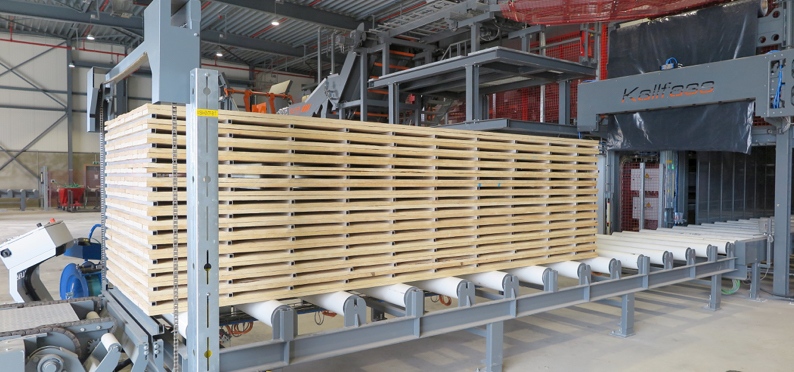
Reliable conveyor transfer
SINGLE FEED UNIT
The quality of individual boards cannot be assessed or measured without precise cycling in. Both the desired production speed and the homogeneity of the timber determine the cycling in process in this respect. With a consistent board thickness and production speed of maximum 80 cycles/min, individual boards are backed up and, using retaining pawls in combination with a plunger and acceleration conveyor, transferred individually to the next conveyor.
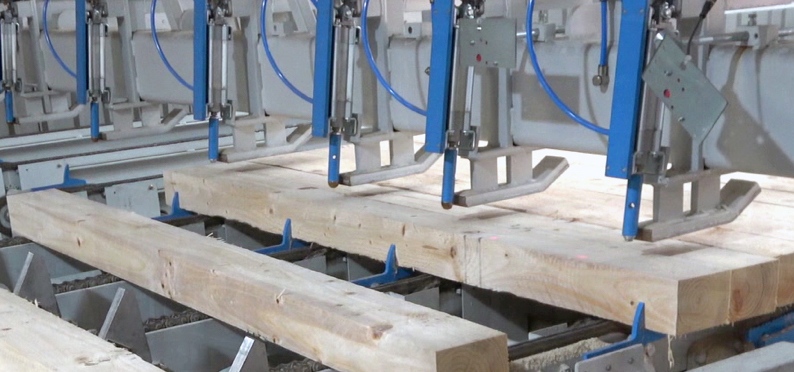
A soon as the thickness of the boards differs or higher production speeds are to be run, powerful TongLoader® units with a gripper system are used. Tong Loader® units can cycle in boards at a speed of up to 240 workpieces/min and are suitable for wet, dry and planed timbers.
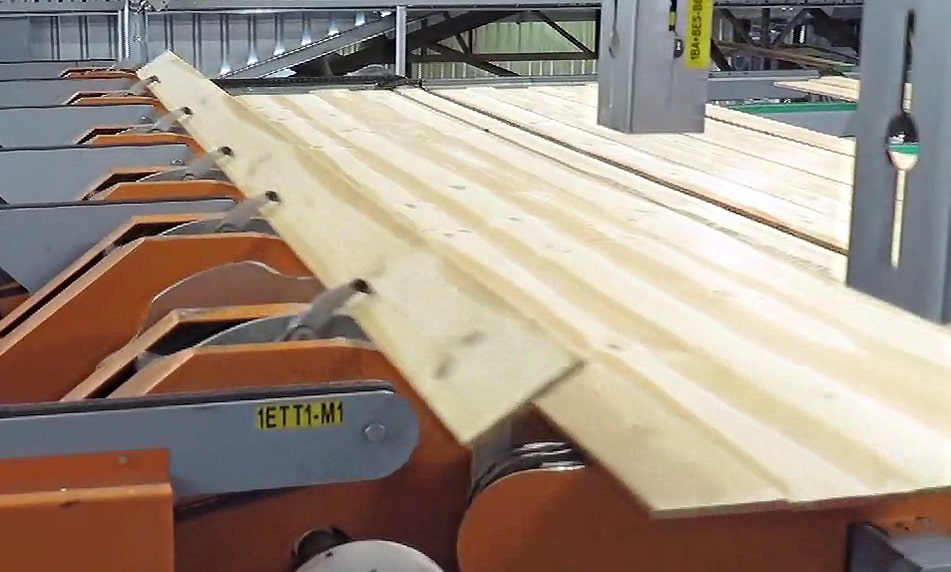
Efficient process sequence
WANE SCANNER
Wane scanners are generally used prior to sorting. In addition to visual detection of the wane to be removed from timber, scanning also determines the length, width and thickness and stores these dimensions as information for subsequent trimming.
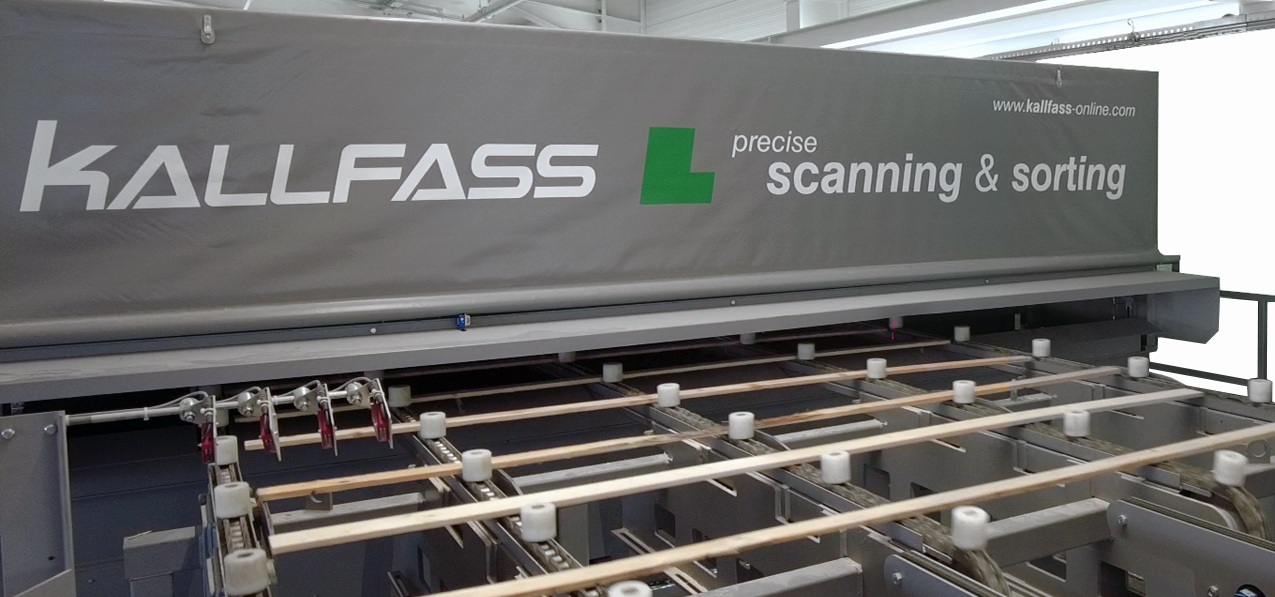
Interactive installation example
Controlled and gentle with material
Controlled timber sorting
UNSCRAMBLING WITH AND WITHOUT SINGLE FEED UNIT
Immediately after a sawing line or tilt destacking, it is often necessary, to separate the workpieces that arrive in a batch in order to form a material film/carpet from which they are then transferred individually or in layers to the next processing step. Depending on the required number of pieces and the material cross-sections, different technologies are used for separation or layer formation.

Continuity at high speed
Classified according to quality
FEEDING: Sorters
Before timber box or level sorters can be added, single item or mixed classification must first be realised according to dimensions and quality. This is aided by warping meters, moisture analysers and wane and quality scanners. Individually assessed sticks or boards are then conveyed on for sorting using a single feed unit or rejected.
Efficient and flexible
Filling at a high cycle rate
INCLINED BOX SORTER
Inclined box sorters are generally used in high-performance productions, as they can be filled at a high cycle rate of up to 160 pieces/min. They ensure reliable emptying of material and are therefore particularly recommended for sorting main boards with large material dimensions.

Sorting with a restricted space requirement
VERTICAL BOX SORTER
Use of a vertical box sorter can be sensible in confined space conditions, as vertical boxes need less space than inclined boxes and can accommodate more product boxes in the same area. Vertical boxes are mainly used for sorting side boards, as the box geometry makes emptying difficult and is not suitable for large material dimensions. The emptying direction can be suitably adapted to optimise the material flow. Vertical boxes are filled at a cycle rate of 120 pieces/min.

Timber product assortment
IDEAL VOLUME
The number of timber products determines the number of boxes. A box should ideally correspond to the volume of a stacked package, with the height of the boxes corresponding to the package cross section.
Time-saving process solutions
Fully automatic material flow
STACKING: Shipping packages
Stacking of timber (including in multiple lengths) can be realised with placement forks or vacuum lifters, with the timber being collected in layers and deposited layer by layer on the shipping package to be formed. Dispatch strips can be laid between several layers to stabilise the shipping package. Strip laying is automatic. Where necessary, the shipping package is stabilised additionally through final strapping. Squared timbers can be optionally included on the package underside, and the packages can be pressed hydraulically together if desired. Customers who do not wish to have stabilising strips (e.g. because the package only needs to be transported within the company) may avail of offset stacking.

Effective air circulation, thanks to dry sticks
STACKING: Kiln packages
Wooden sticks are laid between each layer when stacking timber that is still damp in kiln packages. The intermediate sticks ensure adequate air circulation during drying and accelerate the drying process. The drying sticks are laid by stick magazines.
Option: Workpieces of different widths can also be stacked with spacing with the aid of a servo slide.

Optional equipment
The added bonus for your success! This equipment allows you to enhance your product quality while simultaneously reducing changeover times and personnel costs.
Reliable conveyor transfer
SINGLE FEED UNIT
The quality of individual boards cannot be assessed or measured without precise cycling in. Both the desired production speed and the homogeneity of the timber determine the cycling in process in this respect. With a consistent board thickness and production speed of maximum 80 cycles/min, individual boards are backed up and, using retaining pawls in combination with a plunger and acceleration conveyor, transferred individually to the next conveyor.

A soon as the thickness of the boards differs or higher production speeds are to be run, powerful TongLoader® units with a gripper system are used. Tong Loader® units can cycle in boards at a speed of up to 240 workpieces/min and are suitable for wet, dry and planed timbers.

Efficient process sequence
WANE SCANNER
Wane scanners are generally used prior to sorting. In addition to visual detection of the wane to be removed from timber, scanning also determines the length, width and thickness and stores these dimensions as information for subsequent trimming.

Installation example
Multi-level sorter with film layers
Separation of single and multiple packages
High performance and a high cycle rate
TILT DESTACKING
For separating single and multiple packages with and without intermediate sticks upstream of planing and sorting systems. The packages are received in a transverse direction by a lifting unit, pivoted through approx. 45° and conveyed on to the skid edge. Layer by layer, the timber pieces now slid over a skid edge (which can be flexibly adjusted) to even out distortions in the layer.
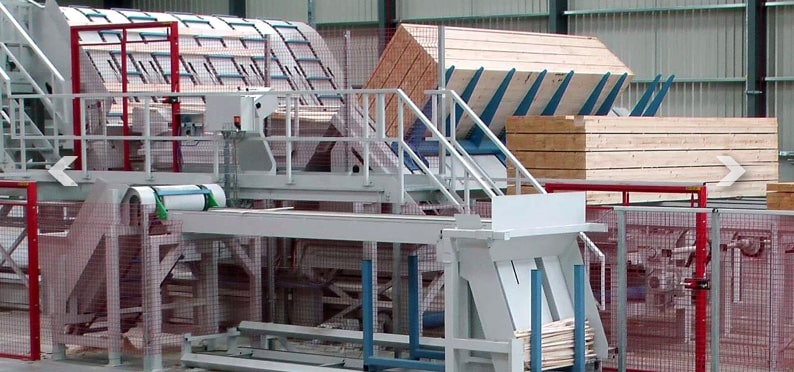
Minimising setup times
TILT DESTACKING OF DOUBLE PACKAGES
Tilt destacking of double packages can halve setup times, minimising production costs as a result. The intermediate strips in double packages can be removed with the aid of a stick stripper (optional) and collected and sorted for further use or disposal.
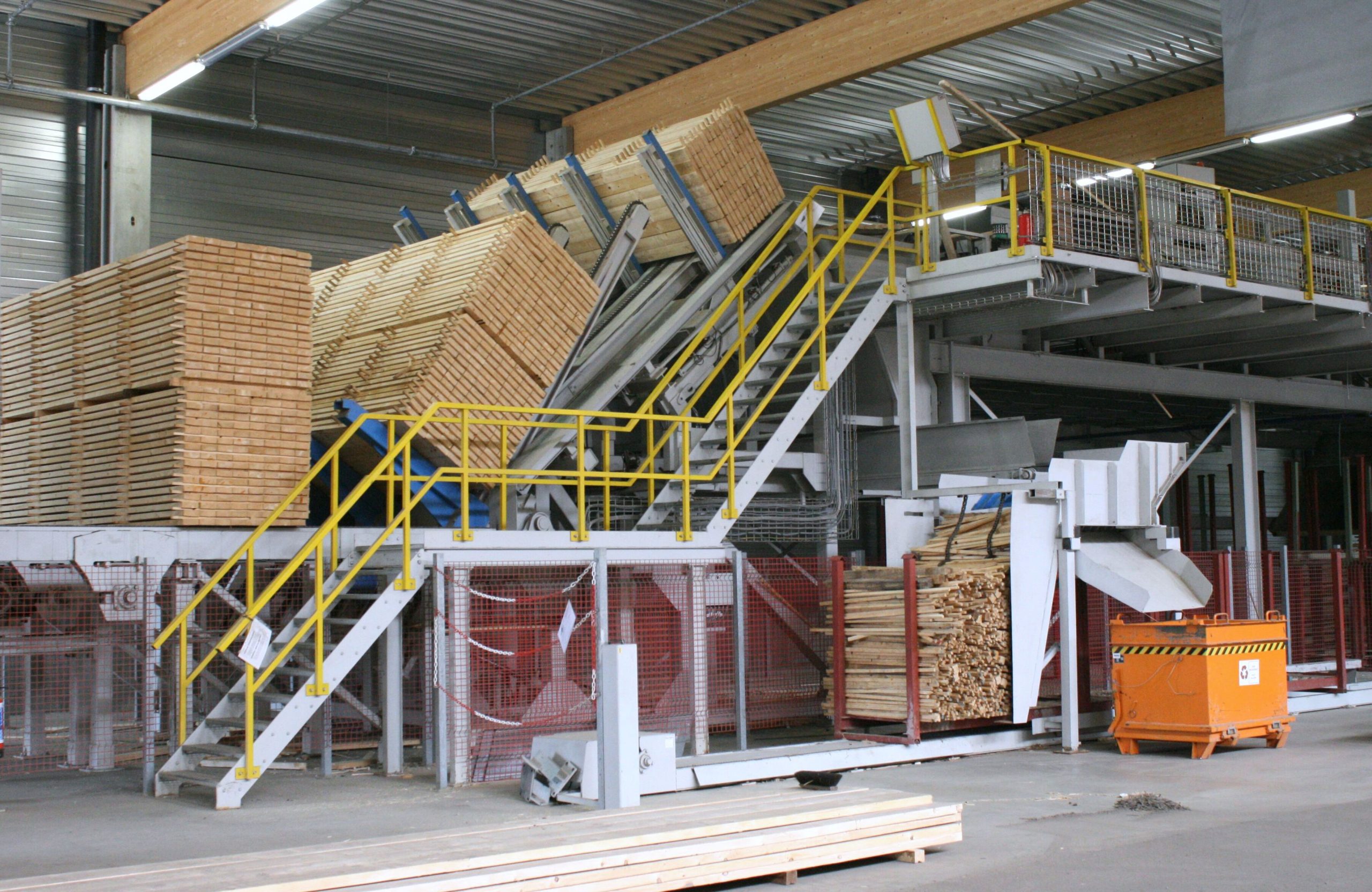
Careful and gentle at a medium cycle rate
VACUUM DESTACKING
VVacuum suckers lift the topmost layer of a package and deposit it gently in a transverse direction on the conveyor. This careful handling is particularly suitable for avoiding surface damage to planed workpieces. The vacuum destacker is suitable for production lines with short to medium cycle rates.
Longitudinally and transversely at a low cycle rate
PUSH-OFF DESTACKING
This destacking involves pushing the uppermost layer of a package to the downstream process. Pushing can occur in a transverse or longitudinal direction, depending on the space requirement. This destacker is used on production lines with a low cycle rate.
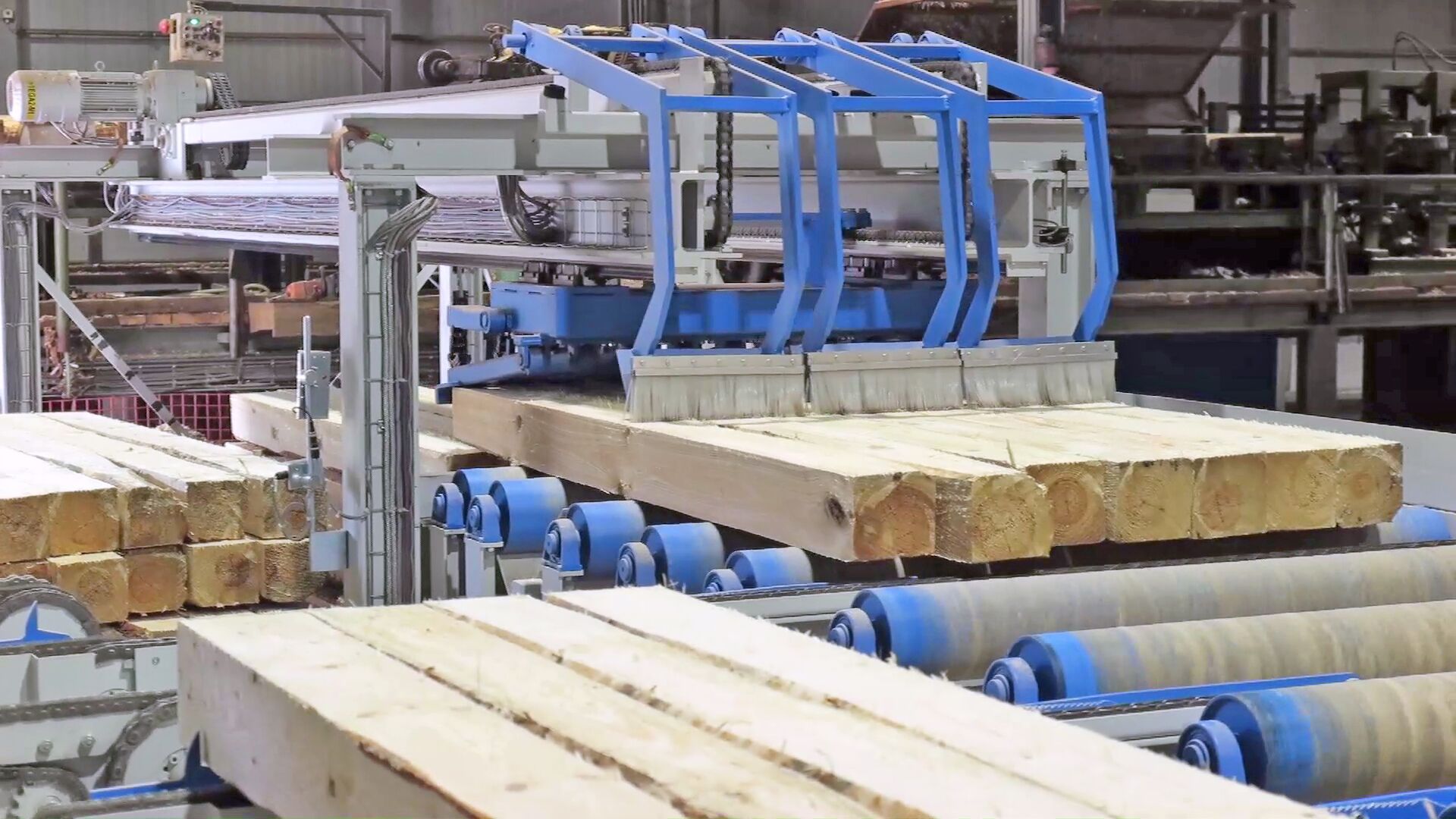
Continuity at high speed
Continuous material supply
FEEDING: Planing machines
Whether in layers or destacked, transverse or longitudinal, a continuous supply of timber is vital when feeding machining processes such as planing or sawing. Accelerating rollers ensure high feed speeds. The use of a slow-down belt is necessary as of a speed of 150m/min to decelerate the pieces after planing.
Continuity at high speed
Classified according to quality
FEEDING: Sorters
Before timber box or level sorters can be added, single item or mixed classification must first be realised according to dimensions and quality. This is aided by warping meters, moisture analysers and wane and quality scanners. Individually assessed sticks or boards are then conveyed on for sorting using a single feed unit or rejected.
Maximum wood protection
Careful material handling and space saving
BUFFER LEVEL SORTER
Use of a buffer level sorter always makes sense where timber should be sorted with as much care as possible, but the sorter should not require excessive space. Nevertheless, the space required by a buffer level sorter is greater than that for a box sorter, as an emptying section must be provided after each level. As the timbers in the levels lie loosely on top of each other and need to be separated prior to filling and after emptying, this sorter is only conditionally suitable for planed workpieces.
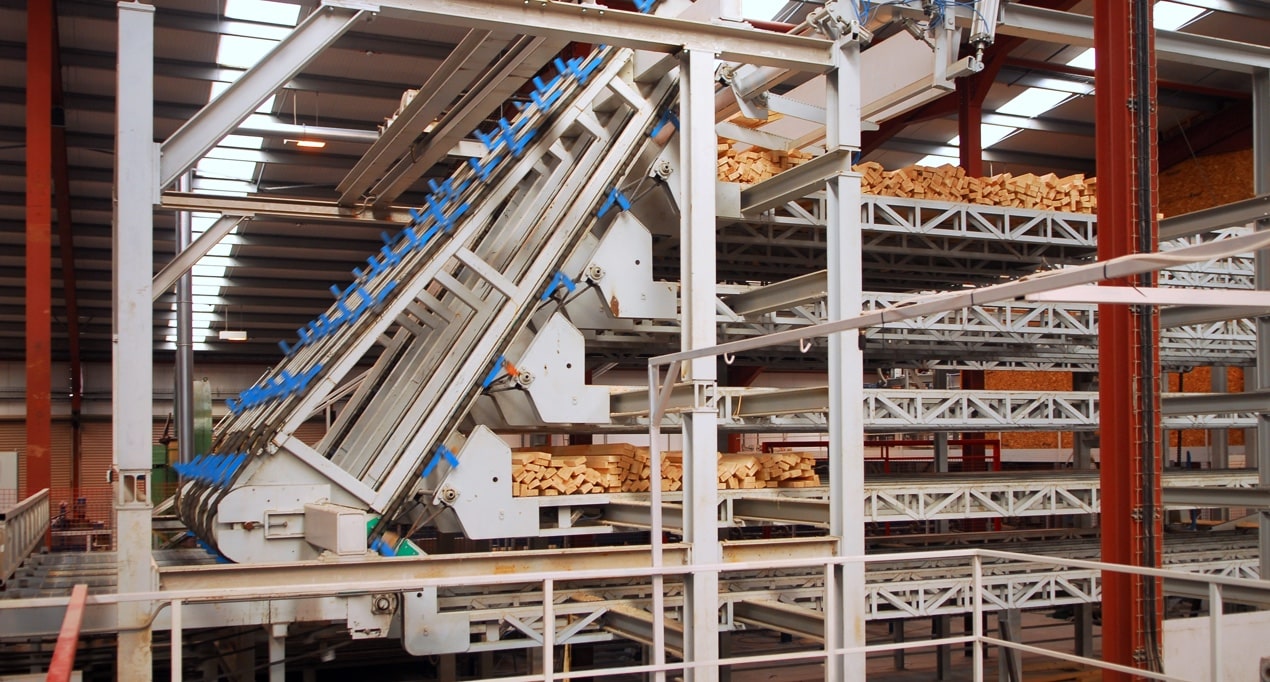
Ideal for planed workpieces
FILM LAYER SORTER
A film layer sorter takes up a lot of space, as the levels are arranged one above the other. However, it is ideal for careful sorting of classified planed timbers, as each board film lies individually in the levels and need not be separated again after emptying. This enables subsequent stacking of the layers and a maximum stacking capacity.
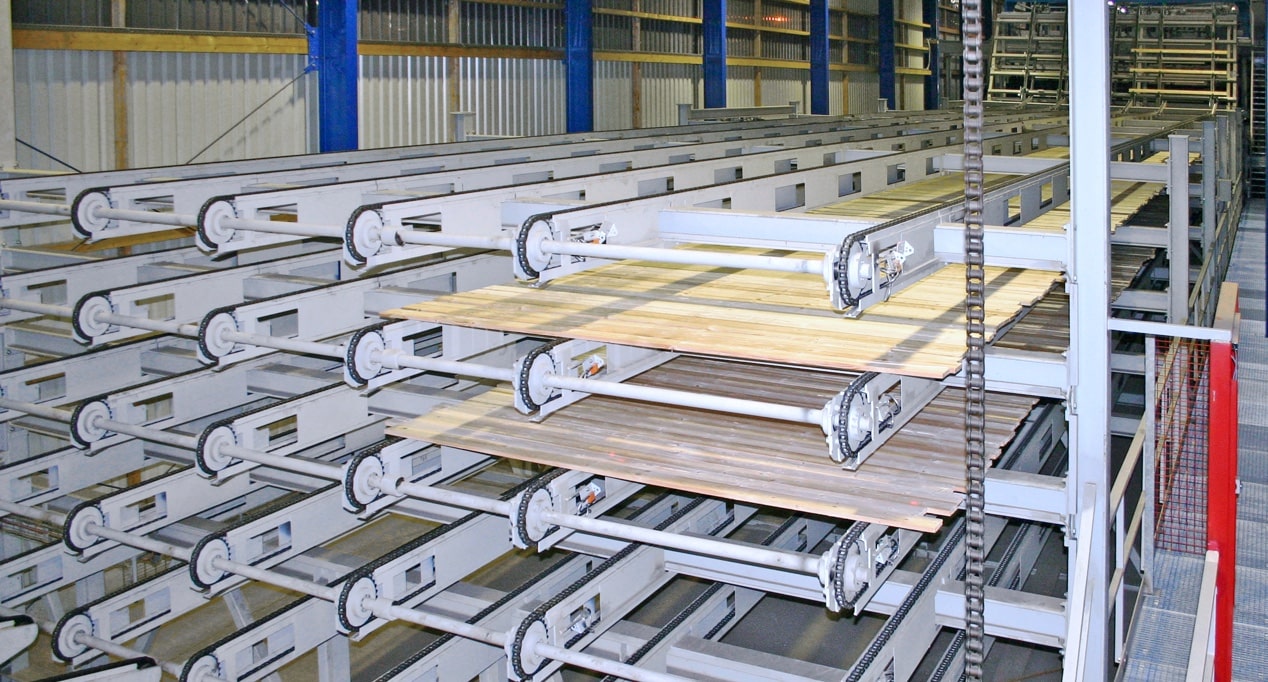
Timber product assortment
IDEAL LAYER LENGTH
The number of assorted products determines the number of levels, and the required length of a level is determined by the cross-sectional size of a package. Filling and emptying of the levels occurs fully automatically in each case.
Continuity at high speed
High throughput
FEEDING: Multiple cross-cut saws
Workpieces can either be fed individually to the multiple cross-cut saw with the aid of a single feed unit or in entire layers, ensuring a constant material flow at even a high production speed.
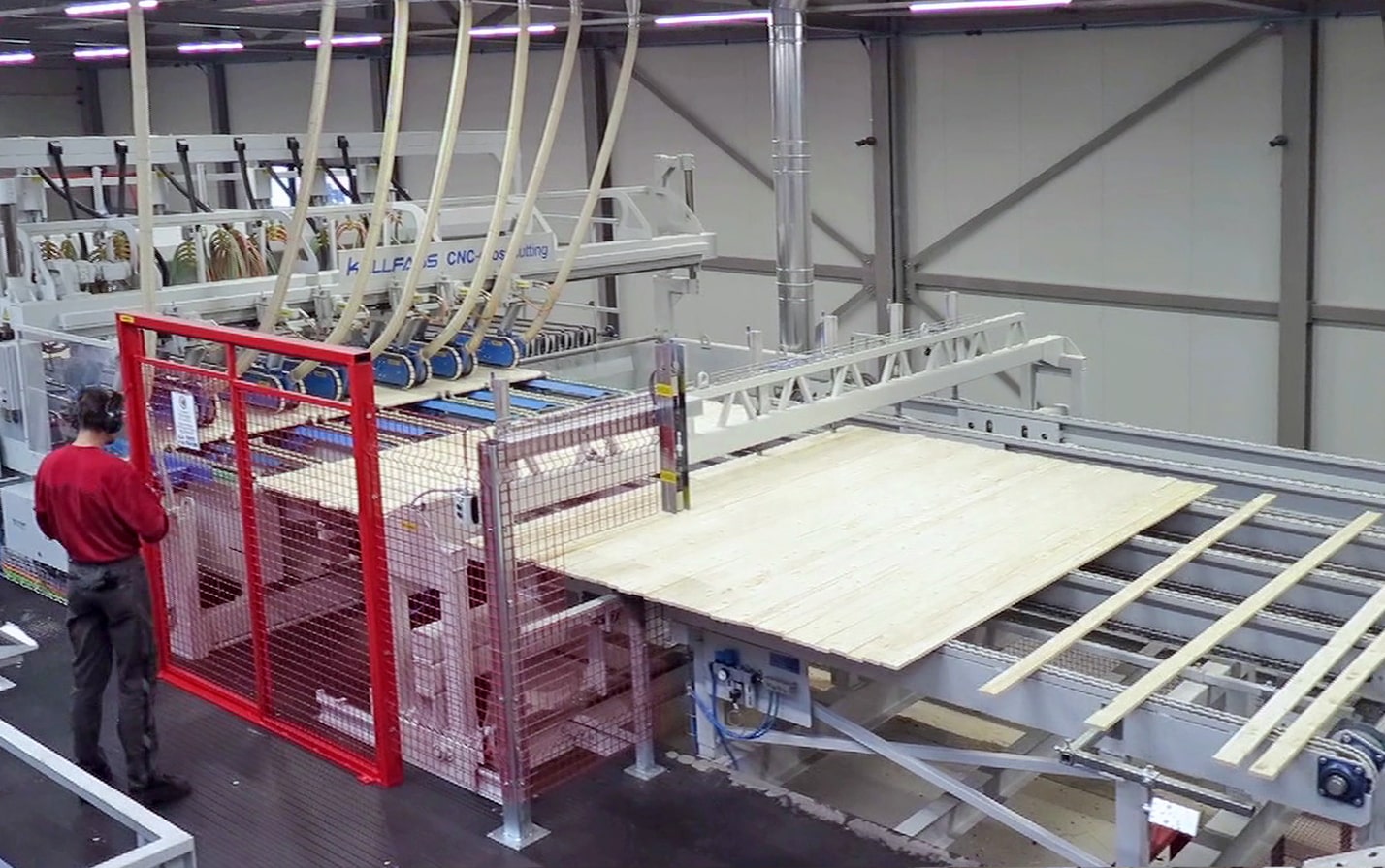
Flexible and efficient
The ends of raw or planed timber workpieces are cut with millimetre accuracy to the desired fixed lengths in cross-cut saws. The workpieces can be processed individually or layer by layer. Powerful saw motors and feed speeds of max. 50 m/min ensure a high throughput.
Several cutting programs can be stored to ensure maximum production flexibility, or data can even be imported from ERP systems and master computers.
Time-saving process solutions
Fully automatic material flow
STACKING: Shipping packages
Stacking of timber (including in multiple lengths) can be realised with placement forks or vacuum lifters, with the timber being collected in layers and deposited layer by layer on the shipping package to be formed. Dispatch strips can be laid between several layers to stabilise the shipping package. Strip laying is automatic. Where necessary, the shipping package is stabilised additionally through final strapping. Squared timbers can be optionally included on the package underside, and the packages can be pressed hydraulically together if desired. Customers who do not wish to have stabilising strips (e.g. because the package only needs to be transported within the company) may avail of offset stacking.

Effective air circulation, thanks to dry sticks
STACKING: Kiln packages
Wooden sticks are laid between each layer when stacking timber that is still damp in kiln packages. The intermediate sticks ensure adequate air circulation during drying and accelerate the drying process. The drying sticks are laid by stick magazines.
Option: Workpieces of different widths can also be stacked with spacing with the aid of a servo slide.

Best timber
QUALITY SCANNER
Quality scanners are used for automated assessment of the quality of dry or moist timber. In a single scanning, multisensors examine the surface of the wood from all four sides and classify the timber according to individual quality parameters. Cracks, discolouring, wane, etc. are detected and localised. All further production steps can be rationalised and optimised as a result.
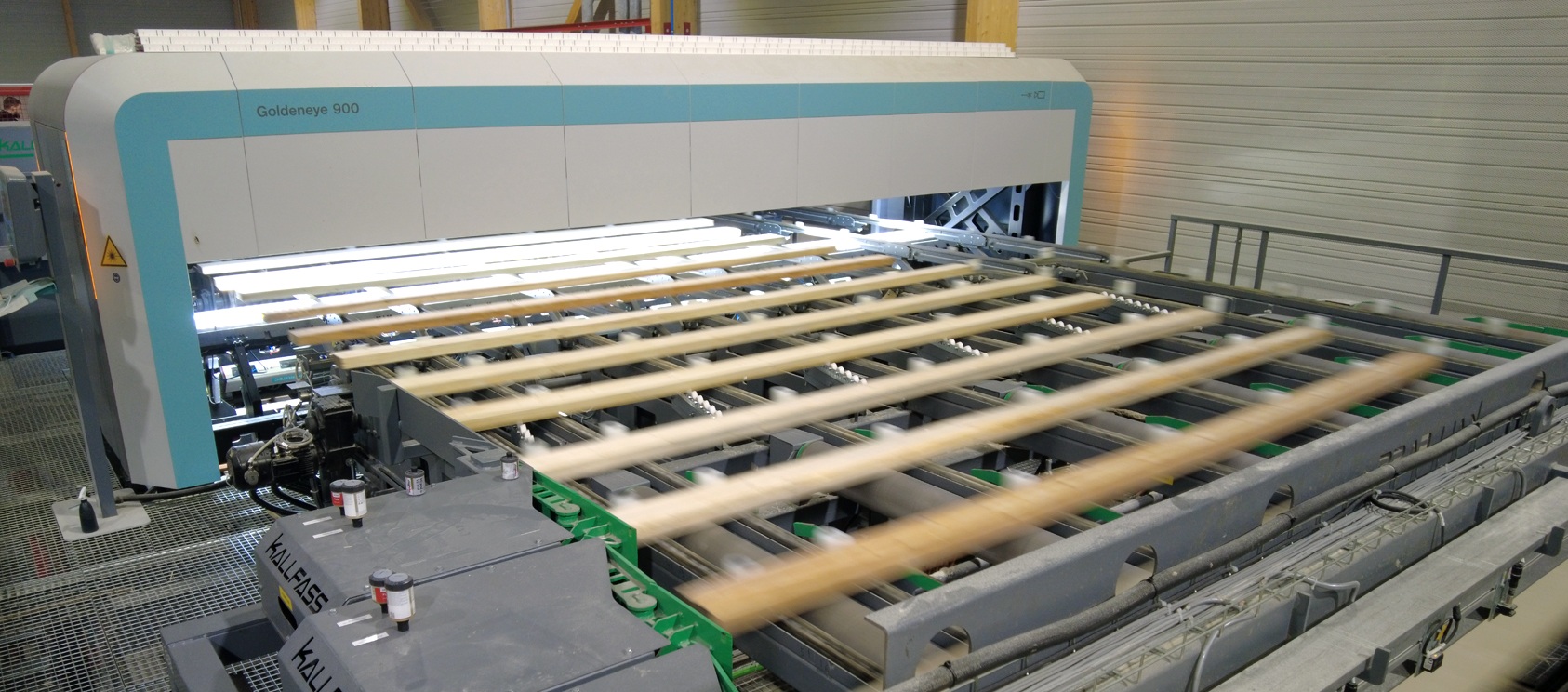
Interactive installation example
Solutions from a one-stop provider
We regard ourselves as a solution partner that assumes responsibility, supporting you from initial consultation and the planning phase right through to successful commissioning of the production line. We train your operating personnel, provide you with comprehensive technical documentation and continue to support you after commissioning with advice and practical help.
Separation of single and multiple packages
High performance and a high cycle rate
TILT DESTACKING
For separating single and multiple packages with and without intermediate sticks upstream of planing and sorting systems. The packages are received in a transverse direction by a lifting unit, pivoted through approx. 45° and conveyed on to the skid edge. Layer by layer, the timber pieces now slid over a skid edge (which can be flexibly adjusted) to even out distortions in the layer.

Minimising setup times
TILT DESTACKING OF DOUBLE PACKAGES
Tilt destacking of double packages can halve setup times, minimising production costs as a result. The intermediate strips in double packages can be removed with the aid of a stick stripper (optional) and collected and sorted for further use or disposal.

Careful and gentle at a medium cycle rate
VACUUM DESTACKING
VVacuum suckers lift the topmost layer of a package and deposit it gently in a transverse direction on the conveyor. This careful handling is particularly suitable for avoiding surface damage to planed workpieces. The vacuum destacker is suitable for production lines with short to medium cycle rates.
Longitudinally and transversely at a low cycle rate
PUSH-OFF DESTACKING
This destacking involves pushing the uppermost layer of a package to the downstream process. Pushing can occur in a transverse or longitudinal direction, depending on the space requirement. This destacker is used on production lines with a low cycle rate.

Continuity at high speed
Continuous material supply
FEEDING: Planing machines
Whether in layers or destacked, transverse or longitudinal, a continuous supply of timber is vital when feeding machining processes such as planing or sawing. Accelerating rollers ensure high feed speeds. The use of a slow-down belt is necessary as of a speed of 150m/min to decelerate the pieces after planing.
Continuity at high speed
Classified according to quality
FEEDING: Sorters
Before timber box or level sorters can be added, single item or mixed classification must first be realised according to dimensions and quality. This is aided by warping meters, moisture analysers and wane and quality scanners. Individually assessed sticks or boards are then conveyed on for sorting using a single feed unit or rejected.
Maximum wood protection
Careful material handling and space saving
BUFFER LEVEL SORTER
Use of a buffer level sorter always makes sense where timber should be sorted with as much care as possible, but the sorter should not require excessive space. Nevertheless, the space required by a buffer level sorter is greater than that for a box sorter, as an emptying section must be provided after each level. As the timbers in the levels lie loosely on top of each other and need to be separated prior to filling and after emptying, this sorter is only conditionally suitable for planed workpieces.

Ideal for planed workpieces
FILM LAYER SORTER
A film layer sorter takes up a lot of space, as the levels are arranged one above the other. However, it is ideal for careful sorting of classified planed timbers, as each board film lies individually in the levels and need not be separated again after emptying. This enables subsequent stacking of the layers and a maximum stacking capacity.

Timber product assortment
IDEAL LAYER LENGTH
The number of assorted products determines the number of levels, and the required length of a level is determined by the cross-sectional size of a package. Filling and emptying of the levels occurs fully automatically in each case.
Continuity at high speed
High throughput
FEEDING: Multiple cross-cut saws
Workpieces can either be fed individually to the multiple cross-cut saw with the aid of a single feed unit or in entire layers, ensuring a constant material flow at even a high production speed.

Flexible and efficient
The ends of raw or planed timber workpieces are cut with millimetre accuracy to the desired fixed lengths in cross-cut saws. The workpieces can be processed individually or layer by layer. Powerful saw motors and feed speeds of max. 50 m/min ensure a high throughput.
Several cutting programs can be stored to ensure maximum production flexibility, or data can even be imported from ERP systems and master computers.
Time-saving process solutions
Fully automatic material flow
STACKING: Shipping packages
Stacking of timber (including in multiple lengths) can be realised with placement forks or vacuum lifters, with the timber being collected in layers and deposited layer by layer on the shipping package to be formed. Dispatch strips can be laid between several layers to stabilise the shipping package. Strip laying is automatic. Where necessary, the shipping package is stabilised additionally through final strapping. Squared timbers can be optionally included on the package underside, and the packages can be pressed hydraulically together if desired. Customers who do not wish to have stabilising strips (e.g. because the package only needs to be transported within the company) may avail of offset stacking.

Effective air circulation, thanks to dry sticks
STACKING: Kiln packages
Wooden sticks are laid between each layer when stacking timber that is still damp in kiln packages. The intermediate sticks ensure adequate air circulation during drying and accelerate the drying process. The drying sticks are laid by stick magazines.
Option: Workpieces of different widths can also be stacked with spacing with the aid of a servo slide.

Optional equipment
The added bonus for your success! This equipment allows you to enhance your product quality while simultaneously reducing changeover times and personnel costs.
Best timber
QUALITY SCANNER
Quality scanners are used for automated assessment of the quality of dry or moist timber. In a single scanning, multisensors examine the surface of the wood from all four sides and classify the timber according to individual quality parameters. Cracks, discolouring, wane, etc. are detected and localised. All further production steps can be rationalised and optimised as a result.

